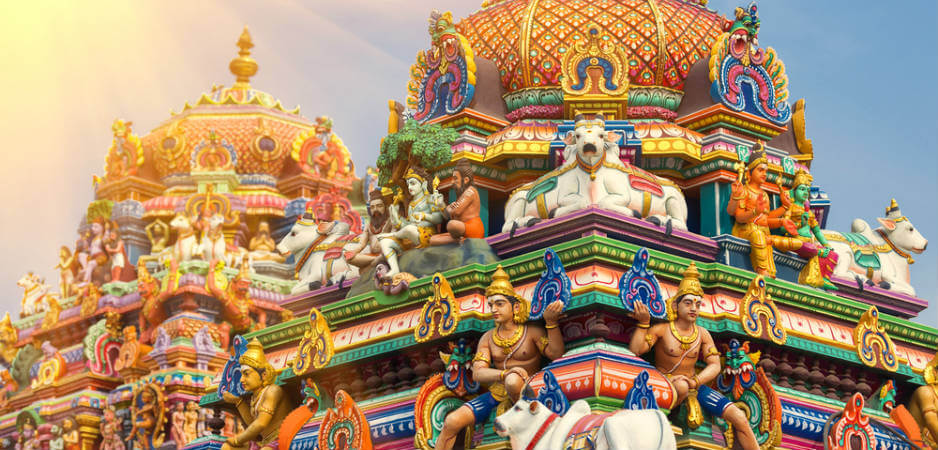In this guest edition of The Interview, Nilanjana Sen talks to Akshaya Mukul, the author of Gita Press and the Making of Hindu India.
Gita Press emerged as an influential player in the Hindi religious publishing world in the 20th century. The founder, Jaydayal Goyandka, and promoters of the press were Marwaris, a mercantile class in India. Gita Press came into existence in 1926, and its publications were reaching the ordinary Hindu households in no time. As a religious publishing house, it had embedded itself in the political developments of colonial India. It sought to save the Hindu religion and counter the influence of Christians and Muslims, who were considered to be foreigners. Even though the Hindus were divided because of the caste system, Gita Press sought to make religious texts such as the Ramayana, Gita and Mahabharata accessible to all the Hindus, including Harijans (former untouchables), in an attempt to unite them against foreigners.
Gita Press produced a monthly journal, Kalyan, reaching a circulation of 100,000 within five years of its inception. In no time, Kalyan became the medium through which cultural organizations such as the Rashtriya Swayamsevak Sangh (RSS) expanded its reach in Hindu households.
In this guest edition of The Interview, Nilanjana Sen talks to Akshaya Mukul, the author of Gita Press and the Making of Hindu India, about the publishing house’s role in shaping the Hindu nationalist project, the moral universe it designed for Hindu women, and how its social agenda got closely intertwined with its political activism in the years leading up to the Partition of India.
Nilanjana Sen: What explains the choice of Gita Press over other Hindi publishing houses to explain the ideological underpinnings of the Hindu nationalist project?
Akshaya Mukul: If you are growing up in places such as Bihar or Uttar Pradesh, Gita Press is very much part of your everyday life. As children, a very attractive aspect of the books published by Gita Press was the detailed and high quality illustrations of mythic stories. Hindu homes would invariably have journals such as Kalyan, published by Gita. While growing up, I noticed that everyone had a story about the publishing house but no one knew about the trust that started it, why it was started and its life more generally as a serious player in the Hindi publishing world.
Some important work had been done on Gita Press recently, but it was very hagiographical in nature written mostly by insiders. The versions produced by them were often heavily sanitized and hid uncomfortable facts.
During the early days of my research I was still tentative about the way a book on the Gita Press will shape up, until I saw the private papers of Hanuman Prasad Poddar, the founding editor of Gita Press and its monthly journal Kalyan, in Gorakhpur. He was a distant relative of Jaydayal Goyandka, the man who set up the Gita Press. Poddar shared close ties with the Hindu Mahasabha, an organization formed in April 1915 to represent the Hindu community. As my research gained momentum, I realized that Gita Press was a massive enterprise, and its work coincided with the larger Hindu nationalist project because both were working in tandem with each other. Gita Press at times acted as a foot soldier and on other occasions provided intellectual sustenance to the Hindu nationalist project. For organizations like the Rashtriya Swayamsevak Sangh, Gita Press publications were of big help since they were reaching ordinary Hindu homes. It helped the RSS expand its reach. Though the RSS, which was founded in 1926, claims to be a cultural organization, it has always had close political links. The Bharatiya Jana Sangh, an Indian nationalist party that existed from 1951 to 1977, and later the Bharatiya Janata Party, were born out of the RSS.
Sen: A running theme in your book is the moral universe pertaining to social conduct, which was defined by publishing companies such as Gita Press. Can you shed some light on this?
Mukul: One of the bases of Gita Press was the revival of the glorious days of Hinduism. This meant that they had to re-create the golden age, which they believed was interrupted by Muslim rule and subsequently by the influence of Christianity following colonization. One of the key ingredients of the golden age was the maintenance of a code of conduct, defined for women. By early 1930s, Poddar was already writing that the inner world was for women, and the outer world was for men. Men will procure, and women will procreate. Gita Press introduced its readers to new developments such as women’s exposure to modern education, the fear of unwanted pregnancies and the potential danger of women marrying outside their caste and religion.
They feared that women with modern education will deviate from the roles assigned to them in the shashtras, which are rules or treatise and refer to the Vedic scriptures. They originated with an oral tradition and were eventually transcribed into texts. Gita Press propagated the view that the role of a woman is to take care of the house and produce a good male child for the nation. This was similar to Adolf Hitler’s rhetoric in Germany, and Gita Press carried a passage on what he said in the annual issue of Kalyan titled Nari Ank (On Women).
It also came up with concocted stories about what education did to women in the United States and England. There is elaborate mention in Kalyan of incidence of pregnancies in hostels and the spread of diseases. The key to understanding the template it followed for almost 90 years now and its philosophy is the editorial Poddar wrote in the first issue of Kalyan in August 1926. He talks of various things that were bothering him, and the new influences on Hindu women was one of them. He prescribed a code of conduct wherein they must not intermingle with men outside their families, and this includes men other than their brother, father, uncles and cousins. In a veiled way, he expressed that interactions with Muslim men should be avoided. There was a long list of prescriptions such as don’t intermingle with Muslim bangle sellers, Muslim tongawallas (horse cart drivers), don’t go to fairs. This was the moral universe the Gita Press created.
Gita Press realized early on that unlike Muslims and Christians the Hindus were divided. The idea was to become the sole spokesperson for the Hindus. They never directly questioned the reformism of social organizations such as Arya Samaj or even the Hindu Mahasabha, which was in favor of temple entry for Dalits [members of lower castes — FO]. Gita Press never took on institutions and organizations directly; rather it presented a more general critique. Through Kalyan it attacked specific changes in society that hinted the influence of outsiders. The moral universe became extremely important for Gita because the crux of sanatana dharma, the eternal Hindu religion that is believed to have existed since time immemorial, revolved around it.
Sen: How do you explain the understanding Gita Press had of the caste system and why the tendency to unite Hindus did not result in granting rights such as temple entry to former untouchables?
Mukul: They believed in the varnashrama dharma (Hindu caste system), the fourfold caste-based classification of Hindu society into Brahmins, Kshatriya, Vaishya and Shudra. If you are born outside the caste system, it had to do with sins you had committed in your past life. They came up with bizarre theories about Harijans (former untouchables) that they used to justify the restrictions on temple entry. Poddar wrote that those who worked with animals have worms in their body.
Societal relations had to be looked at from the standpoint of the fourfold varna system. But there was an ambiguity too. For example, when it came to spreading the gospel of Gita or the Ramayana, they brought out pocket-sized books that were not very expensive and were distributed across all castes. So, while there was a tendency to Hinduize everyone, when it came to letting the same people enter temples, they refused.
Sen: In the book, you refer to the “Marwarization” of Hinduism and this, you argue, was shaped by the crisis of identity among business communities such as the Marwaris. What you are referring to?
Mukul: By beginning of 20th century, Marwaris — the Vaishya, or trading class community — had made their mark as big businessmen. But, at the same time, they had a very bad reputation. Jaydayal Goyandka, the man behind Gita Press, at one point wrote that people do not look at Marwaris with respect because of their business practices. This idea of having been looked down upon despite having money did initiate some soul-searching in the community. By the early part of the 20th century, money began to be used by the Marwaris for philanthropic purposes. It was used to build temples, schools, colleges, inns, hospitals.
And with this also started a new system where the names of the donors began to be placed outside temples, schools, hospitals and inns. Also, Brahmanical rituals got introduced among Marwaris. They began wearing the sacred thread. So, the Marwaris were trying to break away from the reputation they had and this was done using the enormous wealth the community had. At one level, you had philanthropy and on another the Brahmanization of Marwaris to deal with this identity crisis. But one very interesting thing they did during this time was that they began to bankroll gaurakshini sabhas (cow-protection societies).
Financially, the Marwaris had made it big by the first quarter of the 20th century, but at the same time there were popular views about their lack of desire to study. So, you find another very important new development: Some of the earliest publishing houses were run by them. Gita Press was also a Marwari enterprise. It came from a line of thinking within the community that the new generation of Marwaris is going haywire. It was felt that a journal like Kalyan or a publishing house like Gita Press would help them get back on track. Before Kalyan they had started some other journals where the focus was on the community.
There were two streaks of reform within the community. One was the G.D. Birla, Jamnalal Bajaj-variety that focused on modern education, cutting down on ostentatious display of wealth in marriage and other rituals. The other streak was represented by Gita Press that said salvation for Hindus in general, and Marwaris in particular, lay in going back to sanatana dharma and its attendant rituals.
Gita Press was slowly becoming the representative of the entire Marwari community and visibly displayed the desire to unite all Hindus as well. Even today it is run by Marwaris. Gobind Bhawan Karyalaya, the trust behind Gita Press, specifies that the trust will never have a lower caste person as a trustee. In a way, what began to happen was that there was a Brahmanization of Marwaris and Marwarization of Hinduism. Central to this was the control Marwaris had over money, and this allowed them to have a say in education or cow protection, to name but a few issues. The Bania (trading-class) model of bhakti was based on the desire for easy and quick gratification. What I mean by this model is that just like the Banias’ want instant or assured profit, Gita Press propagated that if people followed certain rules, they would immediately benefit. Gita Press had an annual issue called Bhagwan Mahima Ank, which is full of examples of how taking the name of a god helped many ordinary Hindus.
Sen: You mention that the assertion of identity was becoming linked to nationalism after the 1920s. How and why did this shift take place?
Mukul: The 1920s were also a period of intense competitive communalism with both Hindus and Muslims trying to outdo each other in the name of religious identity. It was a period that witnessed maximum number of riots on the issues of cow and music before mosques. There was a consolidation of identity taking place. Poddar was always stressing that the Muslims spoke in one voice, and the Hindus were divided. In his very first editorial in Kalyan, in August 1926, Poddar wrote that there is a need for sangh bal — unity of strength. Against the backdrop of the religious schism, Poddar felt that the only way to deal with it was if Hindus papered over their own differences.
The Hindu right-wing had always been suspicious of Mahatma Gandhi. Gandhi was constantly evolving as a thinker. He had the honesty to say, in 1932, that at some point he opposed inter-dining between upper caste Hindus and lower caste Hindus, but eventually he stopped believing in it. Poddar and Gandhi exchanged long letters. Poddar was against inter-dining and temple entry for Harijans. The relationship between Gandhi and Gita Press began to rupture at this point.
By the 1940s, Kalyan had started to directly attack Gandhi for his views. A year before Partition, the magazine was attacking Gandhi for his role in the break-up of India. The situation was such that when Gandhi was assassinated in 1948, Poddar was also one of those rounded up by police. When the noted industrialist Sir Badridas Goenka wrote to G.D. Birla asking him to get Poddar and Goyankda out of prison, Birla refused and expressed that they were not doing sanatan dharma they were doing shaitan dharma (devil’s religion).
Sen: What explains the intersection of the social agenda and the political activism of Gita Press closer to the years of the Partition of India and independence?
Mukul: The Marwari network helped to popularize Gita Press and spread its social message. If you look at the early days of Kalyan, you will see that within a year it had hit a circulation of 20,000-25,000. Marwaris were buying it in huge numbers and the entire Marwari network was at play. Within five years Kalyan hit a circulation of 100,000. Every time before the special issue would come in the beginning of the year, Poddar would reach out to contributors four months in advance so they had enough time to write. The entire process was meticulously planned. What surprises me is the people who were writing for Kalyan: poets, mendicants, rabid communalists and politicians.
Poddar was fascinating also for the way he reached out to people. People as far as Berkeley were approached, and his persuasion would continue until they agreed to write. Everyone was writing for Kalyan, except some notable exceptions, such as Jawaharlal Nehru. A very large and powerful section of the Congress [Indian National Congress party — FO] was part of the project Gita Press was designing: people like Rajendra Prasad, Madan Mohan Malviya, Seth Govindas, G.B. Pant, to name a few. Despite being part of the Congress that talked about secularism as its ideal, these leaders were closer to those involved in the Hindutva project aimed at establishing a majoritarian Hindu rule.
During the entire Hindu Code Bill controversy, Gita Press had played a significant role, but it hasn’t been chronicled very well. When I went through the records, I realized that Gita Press was the key player in turning public opinion against the bill. Kalyan was not only writing against it but also encouraging and requesting readers to write protest letters that Kalyan would forward to the president of India. The arguments against Hindu Code Bill are the same as the ones we hear against “love jihad” — that the bill will result in our daughters marrying outside their own religion, our daughters will be violated, outsiders will enter our homes, they will cook beef in our kitchens and they will dump our daughters and walk away with our wealth all because the bill would give women the right to property.
The Hindu right-wing consisting of RSS, Hindu Mahasabha and Ram Rajya Parishad was upset with Nehru, and during the 1951-1952 elections they openly supported Prabhudatt Brahmachari against Nehru in the Phulpur constituency. They campaigned through Kalyan against Nehru. During the 1952 elections, concerted efforts were made to tarnish Nehru’s image wherein publicly it was being stated that Nehru consumes beef.
The specter of creation of Pakistan angered and scared Gita Press, Hindu Mahasabha, RSS and many other Hindu outfits. When the Hindu Mahasabha meeting took place at Gorakhpur in 1946, a resolution as to what the new India should be like was passed and Gita Press almost reproduced it. The broad outline was Hindu-centric, propounding that India should be a Hindu nation called Hindustan or Aryavartha, and have a saffron flag. The cow was an important issue and they wanted cow slaughter to be banned. There were other issues too that sought to give a pre-eminent position to Hindus vis-à-vis Muslims like appointments in civil posts and recruitment in the armed forces. In government jobs they wanted Muslims to be appointed based on their percentage in population and this they believed should be done only if Hindus in Pakistan get government jobs proportionate to their population.
So, you see, we are having a replay of sorts of what was desired by the Hindu ring-wing at the time of independence.
*[This article was updated on September 25, 2017.]
The views expressed in this article are the author’s own and do not necessarily reflect Fair Observer’s editorial policy.
Photo Credit: Jayakumar / Shutterstock.com
Support Fair Observer
We rely on your support for our independence, diversity and quality.
For more than 10 years, Fair Observer has been free, fair and independent. No billionaire owns us, no advertisers control us. We are a reader-supported nonprofit. Unlike many other publications, we keep our content free for readers regardless of where they live or whether they can afford to pay. We have no paywalls and no ads.
In the post-truth era of fake news, echo chambers and filter bubbles, we publish a plurality of perspectives from around the world. Anyone can publish with us, but everyone goes through a rigorous editorial process. So, you get fact-checked, well-reasoned content instead of noise.
We publish 2,500+ voices from 90+ countries. We also conduct education and training programs
on subjects ranging from digital media and journalism to writing and critical thinking. This
doesn’t come cheap. Servers, editors, trainers and web developers cost
money.
Please consider supporting us on a regular basis as a recurring donor or a
sustaining member.
Will you support FO’s journalism?
We rely on your support for our independence, diversity and quality.







